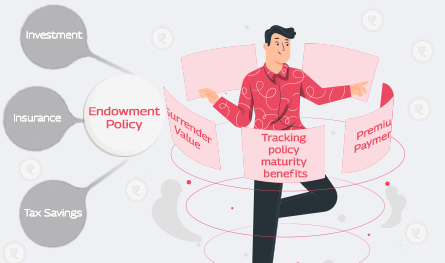How to Manage Your Endowment Policy for Maximum Returns?

An endowment policy is a true investment instrument that combines the benefit of life coverage with the advantage of return on investment. You can choose the amount of premium you can afford, and the life cover offered is usually ten times the annual premium.
The returns are fixed as they are not linked to the market and can be paid out as a lump sum or at regular intervals for mundane expenses. Premiums can be paid monthly, quarterly and even half-yearly at your convenient frequency.

Moreover, after a policyholder's demise, the entire sum assured is paid out to the family members. In the case of survival, the maturity benefits are paid to the policyholder to fulfil any long-term financial goals. The best way to describe this plan is savings with a protection policy.
Managing Maximum Returns Out of Endowment Policy
The tips to ensure that you get the maximum returns from your endowment policy include:
A unique feature of this life insurance plan is the maturity benefits.
These are sum assured amounts paid out in lump sum and include fixed returns and bonuses added over the years. The certainty of this payment makes your financial objectives achievable, irrespective of the market conditions.
Though the rate of returns is conservative, it is guaranteed, which gives you the confidence to utilise your savings for milestones like a child’s higher education or marriage, retirement benefits, and even purchasing properties.
However, it is crucial to keep the policy active by payment of regular income so that your maturity benefit amount is intact. The amount depends on the policy term, premium amount, premium payment term (which can be lesser than the policy term) and age. The sooner you start, the better return you get at maturity. Sometimes, depending on the policy structure, insurance providers also offer Accrued Reversionary bonuses (added annually) and Terminal Bonuses (added at maturity) in participatory policies.
Since endowment policies are long-term, it is crucial to understand that regular premium payment is not an option but a mandate to keep your policy running and enjoy the maturity or death benefits. To keep the regularity of payments, set reminders or auto-debits for premium payments. Take advantage of the grace period, which is 30 days for most policies, to avoid any lapses in payment.
Some policies even offer premium holidays when you can take a break from regular payment while your policy remains active. You need to assess all the benefits while purchasing the policy. Besides, endowment policies of most insurance providers allow policyholders to opt for the flexibility to make payments as per their income and financial situation.
- Regular Payment: you can pay your premiums at periodic intervals throughout the policy tenure, which can be monthly, quarterly, bi-annually or yearly. It is beneficial if you have a regular income source.
- Single Lump Sum Payment: If your income is erratic and you are unsure of a regular payment, a one-time lump sum option is the preferred way to go.
- Limited Payment: You can also restrict the number of premium payment years. Although the coverage and all other benefits extend to the full term of the policy, the payment is required only for a few policy years.
For liquidity too, endowment policies offer a way out in terms of credits or loans. Due to their secured pattern of investment and guaranteed returns, they are lucrative collaterals for loans without even surrendering the plan. The loan amount is usually a percentage of the surrender value of the policy and can offer better interest rates than traditional loans. This may help you tide over unplanned expenses without impacting your long-term financial savings. The protection continues, but funds are made available when you need them. But repayment of the loan is also important if you do not want your maturity payouts to be negatively impacted.
Life is unpredictable. And so is your income and expenditure. They change with time, added responsibilities of family, extra burden of liability, health hazards and many other reasons. These make it challenging to continue with your endowment policy. In addition, you may realise that the return on your endowment funds is not as per your expectation. In such a condition, there are two ways you can exit the policy :
- Surrender the Policy: You can choose to retrieve your funds by surrendering your endowment policy. The surrender amount is equal to a percentage of total premiums paid post deduction of first-year premium. This amount varies for different insurers and can be checked in the policy wording in your insurance documents. But if you surrender before the completion of 3 years, you will end up with nothing.
- Conversion to Paid-Up Status: After 3 years, you may also opt not to pay any more premiums and convert it to paid-up status, where your coverage continues until maturity, and the payout, which is now the paid-up value, is much less than the maturity benefits.
It might seem hard for you to understand when to choose to surrender and when to convert your policy to paid-up status to minimise losses. If the maturity is a few years away, you might want to convert the policy to paid-up status. That way, your coverage continues till the end, and you also get your maturity amount with accrued bonuses. If you still have long enough time till maturity, surrendering may be the best idea. Despite losses incurred, your surrender value will increase with the years. But, if you decide on discontinuance after just one or two premium payments, the policy simply lapses with nil benefits and returns.

Author Bio
Paybima Team
Paybima is an Indian insurance aggregator on a mission to make insurance simple for people. Paybima is the Digital arm of the already established and trusted Mahindra Insurance Brokers Ltd., a reputed name in the insurance broking industry with 21 years of experience. Paybima promises you the easy-to-access online platform to buy insurance policies, and also extend their unrelented assistance with all your policy related queries and services.
Other Life Insurance Products
Latest Post

Health insurance plans are purchased with the hope of medical protection in times of need. However, sometimes it ends up being a source of surprise and disappointment. This mostly happens when people rush to buy health insurance plans, often overlooking essential aspects. Ignoring waiting period clauses, misunderstanding exclusions, and being unaware of sub-limits can lead to unwanted problems in the future.


Term insurance is an important investment. However, with the availability of so many insurers offering term plans, it becomes difficult to select the best term plan to suit your needs. Buying a term plan needs some consideration and research on the part of the policyholder. In this post, let us discuss the best term insurance providers in India.


If you think of life insurance, chances are you are picturing something people buy in their 30s or 40s. But what if you are 65 or older and just getting started? The good news is that you are never too late. Whether you are thinking of easing the financial burden on your family, covering final expenses, or simply leaving behind a legacy, there are life insurance options tailored just for you.
This article will be a guide to life insurance for senior citizens above 65 years, explaining why it is important, the type of insurance options, and how to get the right policy for you.


As any parent will tell you, kids come with two things: endless energy and absolutely no sense of self-preservation. From scaling chairs and tables like mountaineers to catching germs within a five-mile radius, kids really know how to keep everyone on their toes. Now, it is understandable you are worried. As much as we would love to wrap our small ones in cotton wool and keep them safe forever, real life has other plans.

.png)
It is very important to know the car insurance cost in India so that you can find the affordable policy that you are looking for in this case.




